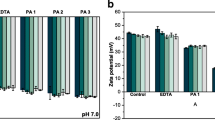Abstract
We investigated the effects of amino acids and peptide on lipid oxidation in emulsion systems. For comparative purposes, we also tested the antioxidant activity of ferulic acid, a typical phenolic antioxidant. Histidine and cysteine retarded lipid oxidation (the amount of thiobarbituric acid [TBA]-reactive substances reached approximately 13 and 18 μM after 7 days, respectively), whereas arginine, methionine, and tryptophan did not inhibit the progression of oxidation. Soy peptide also inhibited lipid oxidation. Ferulic acid was found to be the most effective suppressor of lipid oxidation (TBA-reactive substances were suppressed to <3 μM over 7 days). The antioxidant activities of soy peptide and ferulic acid were related to the purity of the emulsifier used. The radical scavenging activities of soy peptide and ferulic acid were closely related to their inhibitory effects on lipid oxidation. However, this was not the case for amino acids. Decreases in the turbidity of emulsions were closely related to increases in TBA values.






Similar content being viewed by others
References
McClements DJ, Decker EA (2000) Lipid oxidation in oil-in-water emulsions: impact of molecular environment on chemical reactions in heterogeneous food systems. J Food Sci 65:1270–1281
Mendis E, Rajapakse N, Kim SK (2005) Antioxidant properties of a radical-scavenging peptide purified from enzymatically prepared fish skin gelatin hydrolysate. J Agric Food Chem 53:581–587
Marcuse R (1962) The effect of some amino acids on the oxidation of linoleic acid and its methyl ester. J Am Oil Chem Soc 39:97–103
Decker EA (1998) Antioxidant mechanisms. In: Akoh CC, Min DB (eds) Food lipids: chemistry, nutrition, and biotechnology. Marcel Dekker, New York, pp 397–421
Park EY, Murakami H, Mori T, Matsumura Y (2005) Effects of protein and peptide addition on lipid oxidation in powder model system. J Agric Food Chem 53:137–144
Park EY, Murakami H, Matsumura Y (2005) Effects of amino acids and peptides on lipid oxidation in a powdery model system. J Agric Food Chem 53:8334–8341
Park EY, Morimae M, Matsumura Y, Nakamura Y, Sato K (2008) Antioxidant activity of some protein hydrolysates and their fractions with different isoelectric points. J Agric Food Chem 56:9246–9251
Shahidi F, Amarowicz R (1996) Antioxidant activity of protein hydrolysates from aquatic species. J Am Oil Chem Soc 73:1197–1199
Hattori M, Yamaji-Tsukamoto KA, Kumagai H, Feng Y, Takahashi K (1998) Antioxidative activity of soluble elastin peptides. J Agric Food Chem 46:2167–2170
Dickinson E (1997) Properties of emulsions stabilized with milk proteins: overview of some recent developments. J Dairy Sci 80:2607–2619
Buege JA, Aust SD (1978) Microsomal lipid peroxidation. Methods Enzymol 52:302–310
Locatelli M, Gindro R, Travaglia F, Coïsson JD, Rinaldi M, Arlorio M (2009) Study of the DPPH-scavenging activity: development of a free software for the correct interpretation of data. Food Chem 114:889–897
Chen HM, Muramoto K, Yamauchi F, Fujimoto K, Nokihara K (1998) Antioxidative properties of histidine-containing peptides designed from peptide fragments found in the digests of a soybean protein. J Agric Food Chem 46:49–53
Boldyrev A, Johnson P (2002) Carnosine and related compounds: antioxidant dipeptides. In: Johnson P, Boldyrev A (eds) Oxidative stress at molecular, cellular and organ levels. Research Signpost, Trivandrum, pp 101–114
Kohen R, Yamamoto Y, Cundy KC, Ames B (1988) Antioxidant activity of carnosine, homocarnosine, and anserine present in muscle and brain. Proc Natl Acad Sci USA 85:3175–3179
Hernández-Ledesma B, Dávalos A, Bartolomé B, Amigo L (2005) Preparation of antioxidant enzymatic hydrolysates from α-lactalbumin and β-lactoglobulin. Identification of active peptides by HPLC–MS/MS. J Agric Food Chem 53:588–593
Huang SW, Hopia A, Schwarz K, Frankel EN, German JB (1996) Antioxidant activity of alpha-tocopherol and trolox in different lipid substrates: bulk oils vs. oil-in-water emulsions. J Agric Food Chem 44:444–452
Miyashita K (2004) Effects of chemical properties of oil water emulsion on lipid peroxidation. Foods Food Ingredients J Jpn 209:947–954
Author information
Authors and Affiliations
Corresponding author
About this article
Cite this article
Park, E.Y., Nakamura, Y., Sato, K. et al. Effects of Amino Acids and Peptide on Lipid Oxidation in Emulsion Systems. J Am Oil Chem Soc 89, 477–484 (2012). https://doi.org/10.1007/s11746-011-1940-7
Received:
Revised:
Accepted:
Published:
Issue Date:
DOI: https://doi.org/10.1007/s11746-011-1940-7




